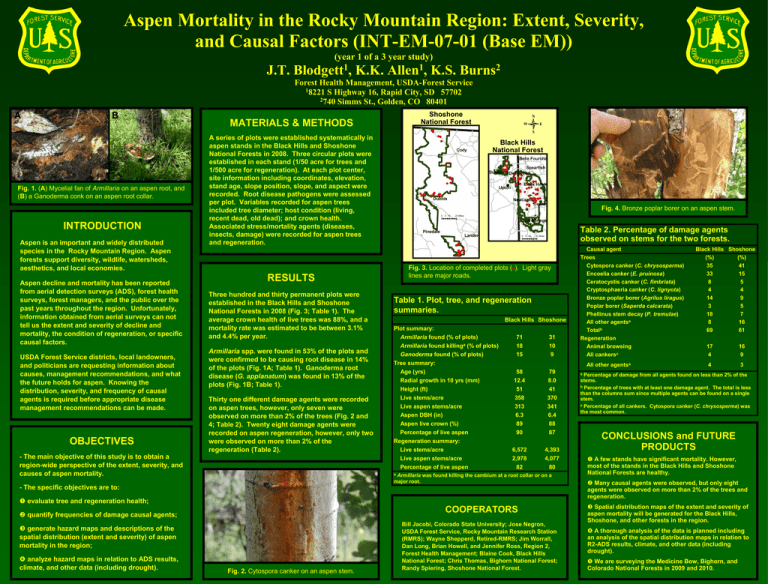Aspen Mortality in the Rocky Mountain Region: Extent, Severity,
advertisement

Aspen Mortality in the Rocky Mountain Region: Extent, Severity, and Causal Factors (INT-EM-07-01 (Base EM)) J.T. (year 1 of a 3 year study) 1 1 Blodgett , K.K. Allen , K.S. 2 Burns Forest Health Management, USDA-Forest Service 18221 S Highway 16, Rapid City, SD 57702 2740 Simms St., Golden, CO 80401 A B Fig. 1. (A) Mycelial fan of Armillaria on an aspen root, and (B) a Ganoderma conk on an aspen root collar. INTRODUCTION Aspen is an important and widely distributed species in the Rocky Mountain Region. Aspen forests support diversity, wildlife, watersheds, aesthetics, and local economies. Aspen decline and mortality has been reported from aerial detection surveys (ADS), forest health surveys, forest managers, and the public over the past years throughout the region. Unfortunately, information obtained from aerial surveys can not tell us the extent and severity of decline and mortality, the condition of regeneration, or specific causal factors. USDA Forest Service districts, local landowners, and politicians are requesting information about causes, management recommendations, and what the future holds for aspen. Knowing the distribution, severity, and frequency of causal agents is required before appropriate disease management recommendations can be made. OBJECTIVES - The main objective of this study is to obtain a region-wide perspective of the extent, severity, and causes of aspen mortality. MATERIALS & METHODS A series of plots were established systematically in aspen stands in the Black Hills and Shoshone National Forests in 2008. Three circular plots were established in each stand (1/50 acre for trees and 1/500 acre for regeneration). At each plot center, site information including coordinates, elevation, stand age, slope position, slope, and aspect were recorded. Root disease pathogens were assessed per plot. Variables recorded for aspen trees included tree diameter; host condition (living, recent dead, old dead); and crown health. Associated stress/mortality agents (diseases, insects, damage) were recorded for aspen trees and regeneration. Three hundred and thirty permanent plots were established in the Black Hills and Shoshone National Forests in 2008 (Fig. 3; Table 1). The average crown health of live trees was 88%, and a mortality rate was estimated to be between 3.1% and 4.4% per year. Armillaria spp. were found in 53% of the plots and were confirmed to be causing root disease in 14% of the plots (Fig. 1A; Table 1). Ganoderma root disease (G. applanatum) was found in 13% of the plots (Fig. 1B; Table 1). Thirty one different damage agents were recorded on aspen trees, however, only seven were observed on more than 2% of the trees (Fig. 2 and 4; Table 2). Twenty eight damage agents were recorded on aspen regeneration, however, only two were observed on more than 2% of the regeneration (Table 2). Black Hills National Forest Fig. 4. Bronze poplar borer on an aspen stem. Table 2. Percentage of damage agents observed on stems for the two forests. Fig. 3. Location of completed plots (¬). Light gray lines are major roads. RESULTS Table 1. Plot, tree, and regeneration summaries. Black Hills Shoshone Plot summary: Armillaria found (% of plots) Armillaria found killinga (% of plots) Ganoderma found (% of plots) Tree summary: Age (yrs) Radial growth in 10 yrs (mm) Height (ft) Live stems/acre Live aspen stems/acre Aspen DBH (in) Aspen live crown (%) Percentage of live aspen Regeneration summary: Live stems/acre Live aspen stems/acre Percentage of live aspen 71 18 15 31 10 9 58 12.4 51 358 313 6.3 89 90 79 8.0 41 370 341 6.4 88 87 6,572 2,978 82 4,393 4,077 80 Armillaria was found killing the cambium at a root collar or on a major root. n evaluate tree and regeneration health; COOPERATORS o quantify frequencies of damage causal agents; p generate hazard maps and descriptions of the spatial distribution (extent and severity) of aspen mortality in the region; Fig. 2. Cytospora canker on an aspen stem. Causal agent Trees Cytospora canker (C. chrysosperma) Encoelia canker (E. pruinosa) Ceratocystis canker (C. fimbriata) Cryptosphaeria canker (C. lignyota) Bronze poplar borer (Agrilus liragus) Poplar borer (Saperda calcarata) Phellinus stem decay (P. tremulae) All other agentsa Totalb Regeneration Animal browsing All cankersc All other agentsa a - The specific objectives are to: q analyze hazard maps in relation to ADS results, climate, and other data (including drought). Shoshone National Forest Bill Jacobi, Colorado State University; Jose Negron, USDA Forest Service, Rocky Mountain Research Station (RMRS); Wayne Shepperd, Retired-RMRS; Jim Worrall, Dan Long, Brian Howell, and Jennifer Ross, Region 2, Forest Health Management; Blaine Cook, Black Hills National Forest; Chris Thomas, Bighorn National Forest; Randy Spiering, Shoshone National Forest. Black Hills Shoshone (%) (%) 35 41 33 15 8 5 4 4 14 9 3 5 18 7 8 16 69 61 17 4 16 9 4 3 Percentage of damage from all agents found on less than 2% of the stems. b Percentage of trees with at least one damage agent. The total is less than the columns sum since multiple agents can be found on a single stem. c Percentage of all cankers. Cytospora canker (C. chrysosperma) was the most common. a CONCLUSIONS and FUTURE PRODUCTS n A few stands have significant mortality. However, most of the stands in the Black Hills and Shoshone National Forests are healthy. o Many causal agents were observed, but only eight agents were observed on more than 2% of the trees and regeneration. p Spatial distribution maps of the extent and severity of aspen mortality will be generated for the Black Hills, Shoshone, and other forests in the region. q A thorough analysis of the data is planned including an analysis of the spatial distribution maps in relation to R2-ADS results, climate, and other data (including drought). r We are surveying the Medicine Bow, Bighorn, and Colorado National Forests in 2009 and 2010.








